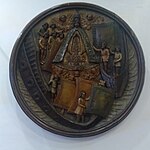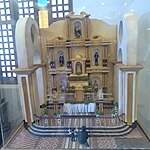Antipolo Cathedral
- Cathedral
- International shrine
- St. Ezequiél Moreno[1]
- Bl. Vicente Soler[1]
- Protacio G. Gungon
- Crisostomo Yalung
- Gabriel V. Reyes
- Francisco Mendoza de Leon
- c. 1591–c. 1632 (dst. 1639)
- c. 1640s (dst. 1645, 1824, 1863, and 1945)
- 1948–1954
Francis Roi Albao Madarang
The International Shrine of Our Lady of Peace and Good Voyage (Filipino: Pandaigdigang Dambana ng Birhen ng Kapayapaan at Mabuting Paglalakbay; Spanish: Santuario Internacional de Nuestra Señora de la Paz y Buen Viaje), popularly known as the Antipolo Cathedral (Filipino: Katedral ng Antipolo; Spanish: Catedral de Antipolo) and alternatively known as the Immaculate Conception Parish (Filipino: Parokya ng Kalinis-linisang Paglilihi),[2] is a Roman Catholic cathedral in Antipolo, Philippines. It enshrines a venerated Black Madonna image of the Blessed Virgin Mary under the title of Our Lady of Peace and Good Voyage (Spanish: Nuestra Señora de la Paz y Buen Viaje), and serves as the seat of the Bishop of Antipolo.[3]
The shrine attracts millions of pilgrims annually, especially during the pilgrimage season from May to July each year.
History
Early churches

The first missionaries of Antipolo were the Franciscans. The first church in Antipolo was built by the Society of Jesus under Juan de Salazar. The Jesuits administered the church from 1591 to 1768. The church was prepared for the image of Nuestra Señora dela Paz y Buen Viaje in 1632. However, the church structure was greatly damaged during the 2nd Sangley Rebellion (1639) and the earthquakes of 1645, 1824 and 1863. The church, meant to house the image of Our Lady of Peace and Good Voyage brought by then-Governor General Juan Niño de Tabora, was supposed to be built on a different plot of land. The church's present location was the site of the tipolo (Artocarpus blancoi), top which the image was found after mysteriously vanishing several times.[4]
The church was completed in 1632, but suffered severe damage in 1639 when the Sangley (Chinese) set fire to the church in a revolt. It was restored afterwards though it was damaged by the 1645 Luzon earthquake, and other earthquakes in 1824 and 1863. Nevertheless, the church became a popular pilgrimage site as many devotees paid reverence to Our Lady of Peace and Good Voyage,[5] including Philippine national hero and polymath José Rizal, who visited the shrine as a boy with his father, Francisco Mercado, on June 6, 1868. The pair went on pilgrimage to fulfill a vow Rizal's mother, Teodora Alonso, had made when she and the boy survived his delivery.[6]
Post-war reconstruction
Towards the end of World War II in 1945, the church was destroyed by Allied bombardment meant to liberate the area from the Japanese imperial control.[4]
After the war, a campaign was organized to build a new church, with the fundraising committee headed by former First Lady Aurora Quezon, and Antipolo parish priest Francisco Avendano. Architect José L. de Ocampo was commissioned to design the new shrine. Construction began in 1948 and was completed in 1954.[4]
On January 14, 1954, the Catholic Bishops' Conference of the Philippines (CBCP) declared the church as the National Shrine of Our Lady of Peace and Good Voyage, making it the first national shrine in the Philippines and Southeast Asia.[7]
The church was elevated to the status of cathedral on June 25, 1983, upon the canonical erection of the Diocese of Antipolo.[7]
Elevation to an international shrine

On July 26, 2021, the Catholic Bishops' Conference of the Philippines (CBCP) endorsed a petition to elevate the cathedral as an international shrine,[8] which was approved by the Holy See's Dicastery for Evangelization on June 18, 2022.[9] The papal decree elevating the cathedral as an international shrine was received on March 13, 2023, and took effect on March 25 (coinciding with the Feast of the Annunciation).[10]
The decree makes it the first international shrine in the Philippines, the eleventh in the world, and the third in Asia after the St. Thomas Church Malayattoor in India, and the Haemi Martyrdom Holy Ground together with the Seoul Pilgrimage Routes in South Korea.[9] It is also the first Marian international shrine in Asia.[11]
The solemn declaration of the shrine was held on January 26, 2024,[12] six months behind its original plan by July 2023.[13] In preparation for this event, a novena was held from January 17 to 25, led by the nine vicariates forane under the Diocese of Antipolo.[14] On the day of the solemn declaration, the image of Our Lady of Peace and Good Voyage was first symbolically crowned by the Bishop of Antipolo, Ruperto Santos, beside Archbishop Charles John Brown, the Apostolic Nuncio to the Philippines. The coronation rites symbolized the cathedral's "new journey as an international shrine." A Mass was then held inside the shrine, presided by Archbishop Brown and concelebrated by eighty bishops comprising the CBCP, with the attendance of top government officials including First Lady Liza Marcos, wife of President Bongbong Marcos.[12]
A Thanksgiving Mass (Misa de Gracia) was held on February 26, 2024, exactly a month after the solemn declaration, presided by the pro-prefect of the Dicastery for Evangelization, Archbishop Salvatore "Rino" Fisichella. On the same day, the shrine received the Golden Rose from Pope Francis, making it the first Marian church in the Philippines and Asia to receive it.[15]
Gallery
- Bas-relief in painted wood depicting the first arrival of Our Lady of Peace and Good Voyage to the Philippines
-
 Krus by Bin Samonte
Krus by Bin Samonte -
 Dome interior, and clerestory windows
Dome interior, and clerestory windows - Cathedra of the Bishop of Antipolo
-

-
 Diorama showing the original sanctuary before its destruction by bombing in 1945. It depicts the thanksgiving pilgrimage of a young José Rizal and his father Francisco Rizal Mercado, holding lit candles, on 6 June 1868.
Diorama showing the original sanctuary before its destruction by bombing in 1945. It depicts the thanksgiving pilgrimage of a young José Rizal and his father Francisco Rizal Mercado, holding lit candles, on 6 June 1868. -
 The plainer sanctuary with its many columns in 1994, before subsequent renovations.
The plainer sanctuary with its many columns in 1994, before subsequent renovations.
References
- ^ a b "Antipolo Cathedral receives relics of St. Ezekiel Moreno, Bl. Vicente Soler". CBCP News. July 3, 2023. Retrieved July 8, 2023.
- ^ a b "Cathedral of the Immaculate Conception, Antipolo, Rizal, Philippines". GCatholic.org. Retrieved April 27, 2023.
- ^ "Diocese of Antipolo". CBCP Online.
- ^ a b c "History". Antipolo: The City of Pilgrimage. December 4, 2011.
- ^ Mercado, Monina (1980). Antipolo: A Shrine To Our Lady. Makati: Craftnotes for Aletheia Foundation.
- ^ Jose Rizal University (2004). "In Calamba, Laguna". JoseRizal.ph. Retrieved May 1, 2015.
6 June 1868 With his father, Rizal made a pilgrimage to Antipolo to fulfill the vow made by his mother to take the child to the Shrine of the Virgin of Antipolo should she and her child survive the ordeal of delivery which nearly caused his mother's life.
- ^ a b Ocampo, Joel V. (June 26, 2022). "Antipolo Church, The First Marian International Shrine in Asia". Retrieved January 26, 2024.
- ^ "Philippine bishops endorse petition to elevate Antipolo church as 'international shrine'". LiCAS News. July 28, 2021. Retrieved March 21, 2023.
- ^ a b "Antipolo Church declared 'international shrine'". Manila Bulletin. June 26, 2022. Archived from the original on June 26, 2022.
- ^ "Antipolo Cathedral now an international shrine as declared by Vatican". GMA Integrated News. March 25, 2023. Retrieved March 25, 2023.
- ^ "Vatican declares Antipolo Cathedral 'international shrine'; first in PH". Philippine Daily Inquirer. June 26, 2022.
- ^ a b Santos, Jamil (January 26, 2024). "Bishops, devotees mark declaration of Antipolo Cathedral as international shrine". GMA Integrated News. Retrieved January 26, 2024.
- ^ Andrade, Nel (March 14, 2023). "Papal decree elevates Antipolo Cathedral into Southeast Asia's 1st International Shrine". Manila Bulletin. Retrieved March 21, 2023.
- ^ Arevada, Lance (January 23, 2024). "'Ahon sa Antipolo': Faithful prepare for pilgrimage site's historic event". Rappler. Retrieved April 18, 2024.
- ^ Hermoso, Christina (February 26, 2024). "Pope Francis gifts Antipolo Cathedral with Golden Rose". Manila Bulletin. Retrieved February 26, 2024.
External links
 Media related to Antipolo Cathedral at Wikimedia Commons
Media related to Antipolo Cathedral at Wikimedia Commons- Official website
- Antipolo Cathedral on Facebook
- Diocese of Antipolo Archived August 9, 2018, at the Wayback Machine
- v
- t
- e
- Rizal
- Marikina

- Protacio Gungon
- Crisostomo Yalung
- Gabriel V. Reyes
- Francisco Mendoza de Leon
- Ruperto Cruz Santos
- Immaculate Conception Cathedral-Parish
| International |
|
|---|---|
| Diocesan |
- Binangonan
- Boso-boso
- Morong
- Tanay
- Cardona
- Teresa
- Nuestra Señora de Aránzazu
- Nuestra Señora de la Paz y Buen Viaje
- Nuestra Señora de los Desamparados de Mariquina
- Nuestra Señora de Fatima de Mariquina
- Ecclesiastical Province of Manila
 Catholicism portal
Catholicism portal Philippines portal
Philippines portal





















